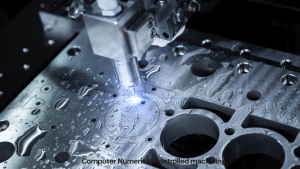CNC machining has been a perfect choice for many industries due to its numerous benefits. The key objective of this article is to present essential information about CNC machining stainless steel, stress the top priority of the alloy choice, and imply the necessity to acquire the proper computer aid design (CAD) and computer-aided manufacturing (CAM) package.
It should be noted that stainless steel has exceptional corrosion resistance as it is one of the most common features of such material, and it also offers high strength and the ability to stand the test of time. It is popular across fields like the aerospace , automotive industry, and the medical and electronics industries. Stainless steel part manufacturing with CNC machines uses a computer to precisely and intricately shape and cut the raw material with computerized instruments. This technique has many advantages compared to other methods of machining that conventional procedures depend on, making it a popular method used by many manufacturers nowadays.
Advantages of using Computer Numerical Controlled machining on Stainless Steel
Together with the CNC machining equipment, precision, and accuracy near the limit of imperceptibility or nearly unnoticeable are the main attractive features of the mechanism. Through computer programs, machine-controlled mechanisms can be accurate to the highest degree of precision, finally guarantee that a product has all the specifications it is supposed to have. This sort of accuracy is pivotal, especially where you would frankly expect that any small deviation could result in an adverse effect.

Another advantage of CNC machining stainless steel over manual processes is the efficiency that CNC machining enables. The key feature of this process is its automated nature, meaning a higher production speed than manual machining. With these superbly time-saving attributes, quicker production time with fewer costs becomes a reality.
The addition of CNC machining stainless steel boosts design versatility, too. The number of small yet extremely fine shapes created by computer-controlled machines is beyond the scope of traditional machining. Thus, the emerging importance of 3D printing is that it revolutionizes product development and innovation.
In addition, CNC machining has a reduced manufacturing process, resulting in cost-effective manufacturing. Although the order amount for CNC machines might hurt the company shortly, the latter is compelled to compromise and pay for those machines since the benefits of them get in line and outweigh their costs. For CNC machining, efficiency and accuracy enable material scrap reduction and minimize the amount of hand labor. As a result, the final price of the production can be kept as low as possible.
Top Alloys for CNC Machining Stainless Steel
When it comes to CNC machining of stainless steel, selecting the right alloy is of significance in the process of success. Here are some of the top alloys commonly used in this process:
- 304 Stainless Steel:Stainless steel is an extensively used general-purpose alloy. It exhibits excellent corrosion resistance and versatility. Offers this feature, which may be utilized in many industries, such as food processing and structural systems within architecture and automotive parts.
- 316 Stainless Steel:The 316 stainless steel gets its superb corrosion resistance credited to the fact that it is most commonly used in marine settings where corrosive chemicals are a major challenge. It is a material of superior strength and durability that can be used for rigorous applications.
- 17-4 PH Stainless Steel: The award-winning alloy was selected because of its excellent high strength, corrosion resistance, and good mechanical properties. [copper alloy] is often applied for space, defense, and medical applications where [toughness and corrosion resistance] are absolutely important.
- 420 Stainless Steel:This material is excellent because of its high hardness and resistance to wearing out. It’s known to make the job great and has applications emphasizing its preferred cutting performance. For instance, it’s used in surgical machines and industrial purposes in medicine.
They are based on different features and advantages. Thus, selecting one alloy over the other depends on the specific end-use requirements.
Stainless steel machining/numerically controlled has many benefits, such as huge quality and high production speed, the ability to design different products simultaneously, and low-cost manufacturing. While it’s true that 3D printing has some advantages, including low cost of production, flexible assembly, and broader design freedom, it also has some disadvantages, including high initial investment, limited material selection, complex programming, and the possibility of tool wear or breakage.
Suitable alloy selection for the CNC machining of stainless steels is very important for getting the desired cuttings. 304 stainless steel, 316 stainless steel, 17-4 PH stainless steel, and 420 stainless steel are the most popular family members of the alloy family involved in this process. Furthermore, every alloy has its unique property that gives it a task-specified application.
In all, CNC machining is a process that gives the industrial world a lot of added value. By knowing the pros and cons of the casting process and selecting an appropriate type of alloy to manufacture the products, producers can optimize their production, and their customers can use high-quality products.
